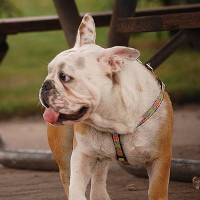Appearance of the Free-Lance Bulldog
|
| The Free-Lance Bulldog is a medium-sized hybrid breed developed by mixing the French Bulldog and the Bulldog. The breed's coat is fine and short, with black, brown, gold and white color combinations. Its sparkling eyes are round and dark, like its nose. Its ears are erect like the French Bulldog, and some puppies can have typical bat ears. Its agile body is athletic and designed for difficult situations. The Free-Lance Bulldog's expression is questioning. Some dogs may develop an overbite like the Bulldog, while others may strongly resemble the French Bulldog in the face. It will have a few wrinkles. |
Temperament of the Free-Lance Bulldog
|
| The Free-Lance Bulldog may not be the best option for new dog owners due to its stubborn and obstinate nature. A lot of training will be needed to keep your dog motivated and learn new tricks and techniques. This breed is intelligent and can feel like it's being tested. Firm commands and positive reinforcement will ensure your Free-Lance Bulldog gets the best training. Be patient and take the time to get to know your adorable dog and he will grow to understand and accept his training. He is a protector and will guard your property and family. In general, he is known to be friendly and social with children. Extra care must be taken with young children to avoid aggressive behavior with a child who may not know when a dog has played enough. It's important to teach him boundaries to avoid any incidents. Your affectionate dog will love being around other dogs, but may need early socialization with other animals. He may be wary of strangers, and it's important to teach him the importance of distinguishing between friendly strangers. Its moderate energy level and laid-back personality mean that it is more at risk of obesity than other breeds. |
Needs and activities of the Free-Lance Bulldog
|
| The Free-Lance Bulldog has a moderate energy level, requiring between 30 and 40 minutes of activity a day. Your affectionate dog will need exercise to prevent obesity, which is notorious in dogs with its stout build. This hybrid will enjoy a walk around the property or neighborhood two or three times a day. He will need you to be aware of his limits when exercising in extreme temperatures. Its flat nose can make it susceptible to shortness of breath. In hot weather, be sure to exercise him in the cool of the day. In cold weather, he'll appreciate a fashionable sweater to keep him warm and dry. He'll adapt to any living environment, whether apartment or house, as long as he gets his fresh air and daily walks. |
Maintenance of the Free-Lance Bulldog
|
| The Free-Lance is not considered a hypoallergenic breed and will shed moderately throughout the year. Brushing him weekly with the smoother brush should be sufficient, although when he's in a seasonal shedding period, you may choose to brush him more often. He may drool a little, and it's important to wipe him regularly to avoid bacteria getting trapped in the folds of his facial skin. If he inherits wrinkles on his body, pay special attention to them and gently wipe hard-to-reach areas with pet wipes, making sure that folds and wrinkles are well dried. Ears should be wiped and cleaned weekly. Nails should be trimmed and filed every 2-3 weeks, and teeth brushed daily as he is prone to tooth decay. |









 English (United Kingdom)
English (United Kingdom)